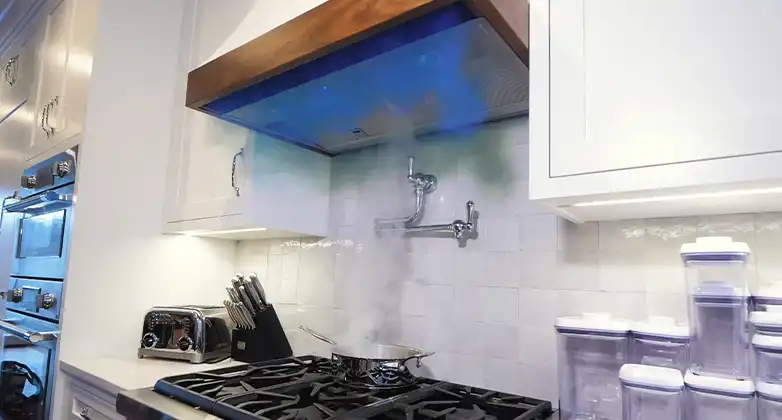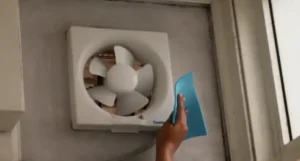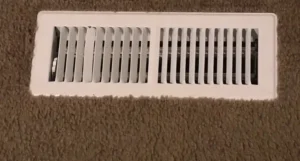Various factors can affect the temperature of kitchen hood exhaust, including the type of cooking, quantity, and effectiveness of the system. However, on average, the temperature of the kitchen hood exhaust is around hundred and fifty to 200 stages Fahrenheit. This temperature variation is considered safe and effective for removing smoke, steam, and odors from the kitchen and preventing grease buildup and other hazardous substances. This article explains what factors affect the kitchen hood exhaust temperature and why a good exhaust system is essential.

How Hot Is the Exhaust from A Kitchen Hood?
Kitchen hoods, also known as range hoods, are common equipment in most current kitchens. Their foremost function is to remove smoke, steam, and cooking fumes from the kitchen, which helps maintain the air clean and fresh. However, when they do their job, they additionally produce warm air. The query is, how hot is the exhaust from a kitchen hood?
The temperature of the kitchen hood exhaust can vary depending on several factors, such as the type of cooking equipment, the air being exhausted, and the distance between the hood and the cooking equipment. Generally, the temperature range of the kitchen hood exhaust is between 100°F (38°C) to 250°F (121°C).
The type of cooking can also affect the temperature range of the kitchen hood exhaust. For instance, frying and grilling can cause the exhaust temperature to increase significantly while baking and steaming may not significantly increase temperature. It is important to note that the temperature of the kitchen hood exhaust should not exceed 500°F (260°C) to avoid any damage to the ventilation system. It is also important to monitor the temperature regularly to ensure it is within a safe range.
Proper maintenance and cleaning of the kitchen hood and exhaust system can also help prevent any grease buildup, which can be a fire hazard. Regularly inspecting and cleaning the ventilation system will ensure that it functions properly and effectively, removing heat, smoke, and pollutants.
Factors that Affect Exhaust Temperature:
A wide range of factors influences exhaust temperature, a fundamental parameter. In this response, we will discuss some of the main factors that impact exhaust temperatures in engines, such as internal combustion engines and fuel turbines. Understanding these elements is indispensable for optimizing average engine performance and decreasing emissions.
- Type of cooking: The type of cooking can affect exhaust temperature. Cooking methods that require higher heat settings, such as searing or frying, can produce hotter exhaust temperatures.
- Size of the kitchen: The size of the kitchen and the hood itself can impact the temperature of the exhaust. Larger kitchens may require a more powerful hood to effectively remove smoke and steam, which could result in hotter exhaust temperatures.
- Hood design: The hood’s design can also impact the temperature of the exhaust. Hoods that could be better designed or more powerful for the size of the kitchen may not effectively remove smoke and steam, which can result in hotter exhaust temperatures.
- Duct length and material: The length and material of the duct that the exhaust travels through can impact the temperature of the exhaust. Longer ducts or ducts made of materials that don’t dissipate heat well may result in hotter exhaust temperatures.
- Ventilation rate: The rate at which the kitchen exhausts air can affect its temperature. A slower ventilation rate may result in hotter exhaust temperatures as the air spends more time in contact with the hood filter.
The Importance of Proper Ventilation:
The exhaust from a kitchen hood can be quite hot, so having the best airflow in the kitchen is crucial. Proper airflow helps end warmness buildup, making the kitchen uncomfortable to work in and decreasing the heart risk. Also, suited ventilation helps dispose of greater moisture from the air, preventing mold and mildew from developing in the kitchen.
How to Measure Exhaust Temperature:
If you’re interested in measuring the exhaust temperature from your kitchen hood, you can use a digital thermometer. Place the thermometer near the exhaust vent and take the temperature reading. Make sure to take multiple readings over time to get an accurate reading.
Frequently Asked Questions And Answers
Is It Necessary to Have a Kitchen Hood?
Yes, it is necessary to have a kitchen hood in your home as it helps to remove smoke, steam, and different cooking byproducts from the air. And this can help improve air quality and stop the buildup of dangerous pollutants.
How Can I Tell If My Kitchen Hood Is Working Properly?
You can tell if your kitchen hood is working properly by checking for airflow and suction. If you notice that your hood is not effectively removing smoke or steam from the air, it may be time to have it serviced or repaired.
What is the Correct Temperature for Kitchen Make-Up Air?
The makeup air supply temperature should be within 10 degrees F of the room temperature to maintain occupant comfort. When a house is maintained at 70 degrees F in winter, makeup air should be supplied at no less than 60 degrees F.
How Often Should I Clean My Kitchen Hood?
Clean your kitchen hood every six months to prevent the buildup of grease and other debris buildup, which can cause a furnace fire. However, if you prepare dinner frequently or use your hood heavily, you may need to clean it more often.
Conclusion
For anyone designing or operating a kitchen ventilation system, the temperature of the kitchen hood exhaust is vital. While the temperature can differ depending on several factors, it is typically between hundred and 200 degrees Fahrenheit. By appreciating the temperature of the exhaust and monitoring it regularly, you can ensure that your kitchen ventilation system is operating safely and effectively.



![Read more about the article [4 Fixes] Why Won’t My Range Hood Fan Turn Off?](https://kitchenhoodcare.com/wp-content/uploads/2023/05/Why-Wont-My-Range-Hood-Fan-Turn-Off-300x161.webp)